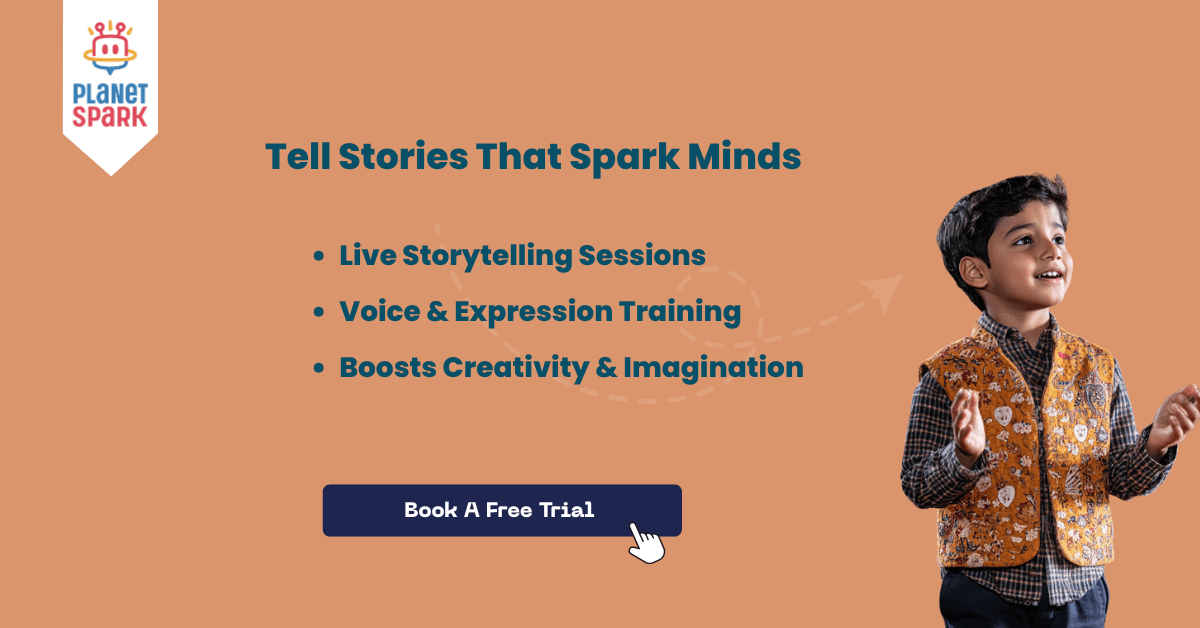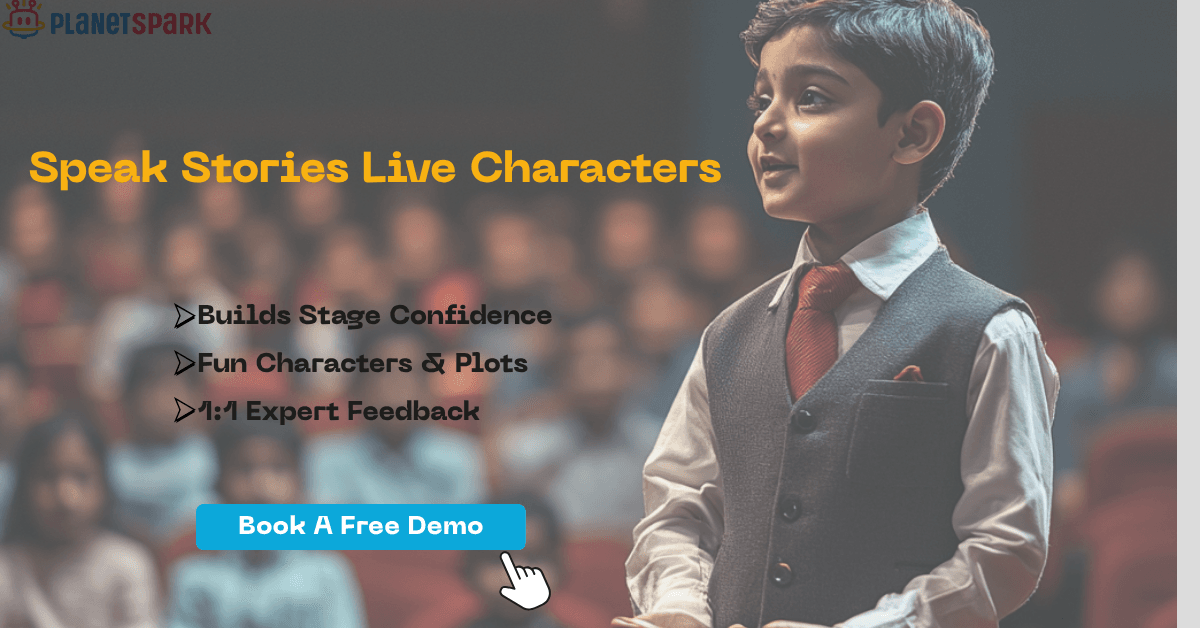How PlanetSpark Builds Q Word Fluency and Storytelling Confidence

Table of Contents
- Defining Storytelling
- Importance of Storytelling
- Key Elements of Storytelling
- How to Be a Good Storyteller
- Applications of Storytelling in Real Life
- Storytelling Techniques for Different Age Groups
- Types of Storytelling Formats in Modern Education
- Common Storytelling Mistakes and How to Avoid Them
- Storytelling Exercises You Can Do at Home
- How PlanetSpark Nurtures Young Storytellers
- Why Should Your Child Learn Storytelling?
- Conclusion: We Are All Storytellers
- FAQs
Storytelling has played a vital role in human history since ancient times. It has helped people interpret the world around them and find deeper meaning in life. While storytelling techniques have evolved, their power to engage, educate, and connect audiences remains timeless. The best public speakers are often skilled storytellers who use narrative techniques to make their messages impactful and memorable.
“Nothing sticks in your head better than a story. It can express the most complex ideas in the most digestible ways.” - Sam Balter
But what exactly is storytelling, and how does it relate to public speaking? Let’s explore.
Defining Storytelling
Storytelling is an interactive art form that combines words and actions to paint vivid mental images and stimulate the imagination of the audience. It transcends cultures and languages, making it a universal form of expression. Storytelling builds communities and strengthens communication across backgrounds.
In public speaking, storytelling is essential. It captures attention, fosters emotional connections, and is often easier to recall than memorized scripts. Great storytellers can transform ordinary moments into compelling narratives. By adding a personal touch, speakers can make even simple stories resonate deeply.
Want to start your storytelling journey? Attend a FREE class by a PlanetSpark expert and take your first step!
Importance of Storytelling
Storytelling is a cornerstone of effective public speaking. Everyone has a story, and with consistent practice, anyone can improve their storytelling skills. Here are a few ways storytelling makes an impact:
1. Storytelling is Interactive
It's a two-way process influenced by the audience's reactions. A good storyteller adjusts tone, pace, and emphasis based on listener engagement.
2. Storytelling Builds Honest Communication
Storytelling predates written language and is a natural method for learning grammar and vocabulary. It nurtures structured communication and boosts the speaker's confidence.
3. Storytelling Enhances Imagination
Storytelling helps children visualize scenes and characters, boosting their creative and imaginative abilities.
4. Storytelling Encourages Expressiveness
An expressive speaker captivates the audience. Through storytelling, one learns to modulate voice, facial expressions, and gestures effectively.
5. Storytelling Improves Vocabulary
New words are better learned in context. Stories help learners understand and remember new vocabulary more easily.
Key Elements of Storytelling
Every good story relies on five key elements:
1. Character
Characters are central to a story. Audiences tend to relate more to people and emotions than to abstract ideas.
2. Plot
A sequence of events that form the story. Let the plot evolve organically as you write, based on character motivations.
3. Expressions
Vary your voice and use facial expressions to match the tone and mood of the story.
4. Words
Carefully chosen words bring a story to life. They evoke emotion, paint vivid pictures, and forge strong connections with listeners.
5. Structure
All stories need a clear beginning, middle, and end. A well-structured story keeps audiences engaged and offers a satisfying conclusion.

How to Be a Good Storyteller
1. Practice with Friends and Family
No skill improves without practice. Rehearsing in front of others helps refine rhythm, identify gaps, and gain confidence. Want expert feedback? Book a FREE storytelling class today!
2. Write a Story Every Day
Daily writing expands creativity and perspective. Try different genres to broaden your skills.
3. Engage with the Audience
Great storytellers interact with their listeners through eye contact, gestures, and expression. Make your audience feel like part of the story.
4. Stay Calm
Nervousness can disrupt your delivery. Practice relaxation techniques and focus on a steady pace.
5. Keep It Crisp
Avoid unnecessary details. A concise story with relevant highlights holds attention better.
6. Make It Personal
Sharing personal stories builds emotional resonance. Use relatable emotions and experiences to connect with your audience.
Applications of Storytelling in Real Life
Storytelling isn’t limited to bedtime tales or dramatic performances. It’s a communication superpower that can be applied in daily life across all age groups and professions. Let’s explore how storytelling plays a meaningful role in different areas of life:
1. In Education
Teachers who use storytelling as a teaching method make concepts easier to understand and retain. For example, a math teacher can introduce word problems through short narratives that involve characters and real-life situations. This adds context, builds interest, and encourages children to engage with the subject more meaningfully.
2. In Business
Leaders and entrepreneurs often use storytelling to pitch ideas, communicate brand values, or inspire employees. A simple anecdote can leave a lasting impact compared to statistics or graphs. Storytelling helps humanize brands, connect emotionally with customers, and build loyalty.
3. In Family and Social Settings
Parents use storytelling not just to entertain but to pass on values, cultural traditions, and life lessons. Family storytelling builds stronger emotional bonds and creates cherished memories. It also helps children develop listening and communication skills in a nurturing environment.
4. In Job Interviews
Candidates who share personal stories related to their achievements, challenges, or growth journeys tend to stand out. Storytelling during interviews adds authenticity and relatability, making your profile more memorable and persuasive.

Storytelling Techniques for Different Age Groups
The approach to storytelling should vary based on the listener’s age, interest, and learning level. Here’s how storytelling adapts across different developmental stages:
For Early Learners (Ages 4–7):
Use simple vocabulary and repetitive phrases.
Incorporate rhymes, sounds, and songs.
Add visual aids like picture books or puppets.
Focus on moral stories with clear lessons.
For Tweens (Ages 8–12):
Introduce longer narratives with more complex plots.
Include humor, suspense, or mystery to maintain engagement.
Allow them to co-create stories to boost their creativity.
For Teenagers (Ages 13–18):
Explore themes around identity, friendships, and ambitions.
Use personal experiences to create relatable narratives.
Introduce narrative writing or spoken storytelling formats like slam poetry.
Want to learn how storytelling adapts to different learning levels? Check out PlanetSpark’s storytelling approach for every age group.
Types of Storytelling Formats in Modern Education
With advancements in technology and pedagogy, storytelling has evolved into various engaging formats. Here are some popular ones used in modern learning environments:
1. Digital Storytelling
Combines multimedia elements - audio, video, text, and animation - to tell a compelling story. Used in classrooms and online courses to present complex topics in an easy-to-understand format.
2. Interactive Storytelling
Gives children the power to choose how a story progresses. Think of “choose your own adventure” books or games that allow multiple outcomes based on decisions.
3. Visual Storytelling
Relies on images, charts, infographics, and comics. Perfect for learners who process information better visually.
4. Role-Playing and Dramatization
Children act out stories, helping them improve empathy, voice modulation, and body language. This method is a core part of PlanetSpark’s storytelling course curriculum.
Want your child to experience all these storytelling methods firsthand? Explore the PlanetSpark Storytelling Course today!
Common Storytelling Mistakes and How to Avoid Them
Even the most engaging speakers sometimes make mistakes while telling stories. Recognizing and addressing these issues can take your storytelling to the next level:
Mistake 1: Dragging the Story
A long, winding story with too much detail can bore listeners.
Fix: Stick to essential plot points. Keep it short, structured, and impactful.
Mistake 2: Lack of Emotion
If your voice is flat and facial expressions are missing, the story loses its charm.
Fix: Use emotion in your tone, voice inflections, and gestures to reflect the story’s mood.
Mistake 3: Forgetting the Audience
Telling a story that your audience can’t relate to causes disconnection.
Fix: Adapt your story to the interests and age of your listeners.
Mistake 4: No Takeaway
An aimless story may confuse the audience.
Fix: End your story with a message, lesson, or strong conclusion.
Storytelling Exercises You Can Do at Home
Here are some fun and effective exercises parents can do with their children to build storytelling confidence:
Picture Prompt Story
Choose any random image and ask your child to build a story around it. It stimulates creativity and teaches structure.
Roll-a-Story
Create dice labeled with characters, settings, and conflicts. Roll them and make up stories using the combination that appears.
Story Swapping
Start a story and let your child continue it, then take turns until the story ends. It enhances improvisation skills and listening.
Mirror Storytelling
Stand in front of a mirror and narrate a story. This helps practice expressions, posture, and eye contact.
These techniques are also part of PlanetSpark’s curriculum. Want to give them a try? Book a free demo storytelling class and let your child experience it live.
How PlanetSpark Nurtures Young Storytellers
At PlanetSpark, we don’t just teach kids to read or speak-we teach them to connect through stories. Our storytelling course is designed with:
Live, expert-led sessions that guide children through all elements of narrative creation.
Interactive activities like skits, character roleplays, and digital presentations.
Feedback-driven storytelling where children present their stories and receive real-time feedback.
AI-based performance analytics that track fluency, emotion, and voice modulation.
Visual storytelling modules to teach kids how to use illustrations and slides as storytelling tools.
Do you wish to make your child grow with PlanetSpark? Read our blog on The Art of Storytelling.
Why Should Your Child Learn Storytelling?
1. Instills Ethics and Values
Stories teach honesty, kindness, courage, and other positive traits children emulate in real life.
2. Enhances Communication
Storytelling fosters better expression and helps expand a child's vocabulary.
3. Builds Cultural Awareness
Traditional stories instill an understanding of roots, traditions, and global cultures.
4. Develops Focus and Listening Skills
Engaging stories keep kids attentive, enhancing their ability to listen and process information.
5. Boosts Creativity
Storytelling encourages children to imagine and create their own narratives.
6. Develops Social Skills
Listening to and sharing stories helps children become more empathetic, patient, and cooperative.
Want to nurture your child’s imagination and language skills? Enhance your child's visual storytelling skills with PlanetSpark.
Conclusion: We Are All Storytellers
Every person is inherently a storyteller. From daily experiences to imagined tales, storytelling is embedded in our communication. Whether you're talking to a friend or presenting at work, you tell stories to entertain, explain, or persuade.
While we all possess this instinct, refining your storytelling technique enhances your ability to connect with others. Watch TED talks, read great stories, or join a storytelling course to grow.
FAQs
1. What are the four types of storytelling?
- Value Story
- Vulnerable Story
- Informative Story
- Entertaining Story
2. What are the five elements of storytelling?
- Character
- Plot
- Expressions
- Words
- Structure
3. What are the 4 Ps of storytelling?
- People
- Place
- Purpose
- Plot
4. Why is storytelling important?
Storytelling helps convey complex ideas, triggers emotion, and builds audience connection. It stimulates the brain and improves retention.
5. What is a storytelling technique?
It refers to how a story is presented. Techniques include introducing likable characters, strong plots, and personal touches to enhance delivery.
6. What are the methods of storytelling?
- Oral Storytelling
- Visual Storytelling
- Written Storytelling
- Digital Storytelling
Personalized Communication Report
Record a video to get a AI generated personalized communication report for your child

Hi There, want to try these
tips for your child with
LIVE with our expert coach?
Let's check your child's
English fluency
